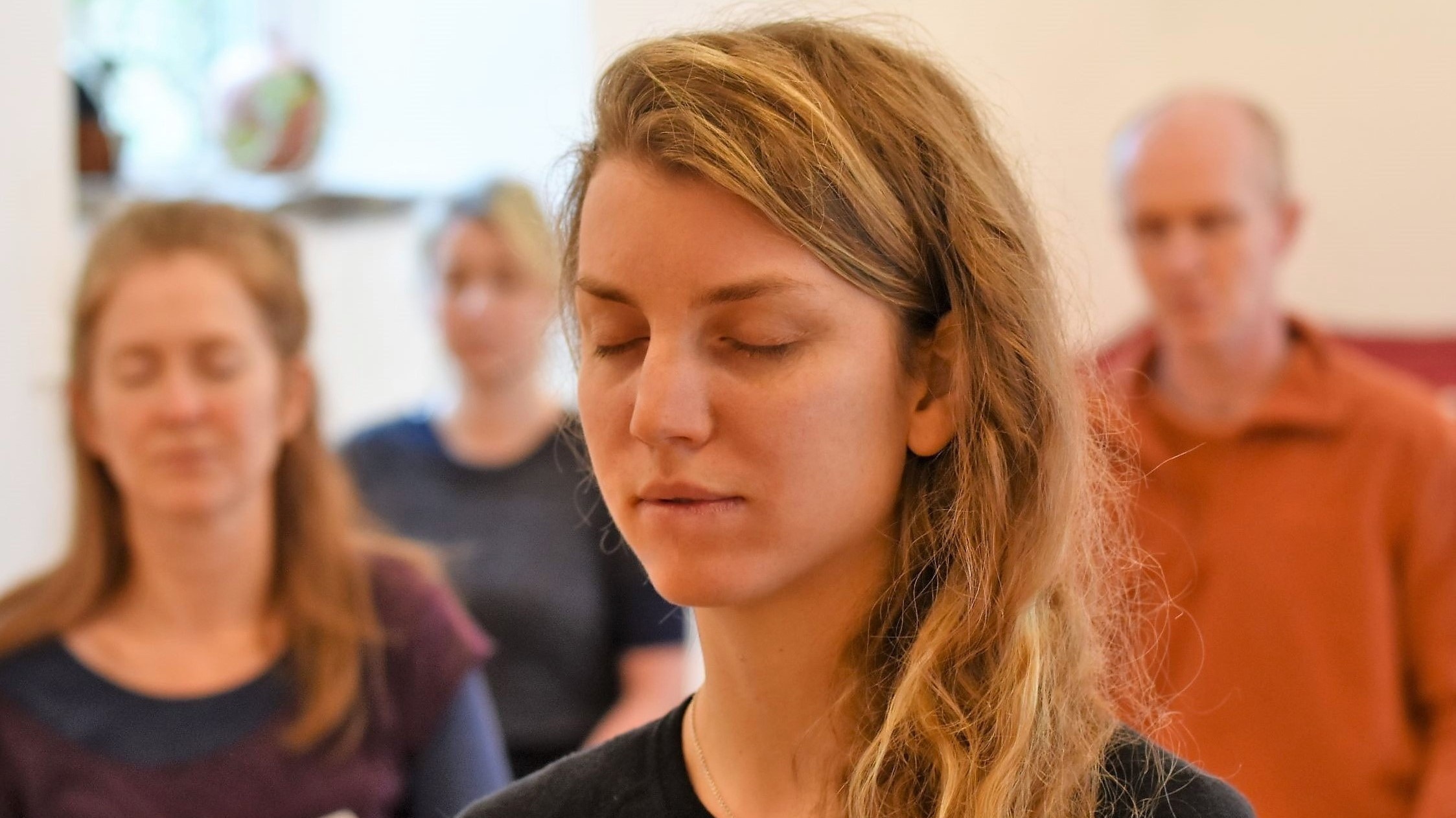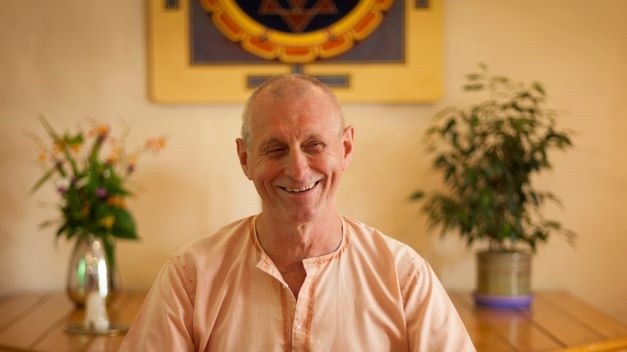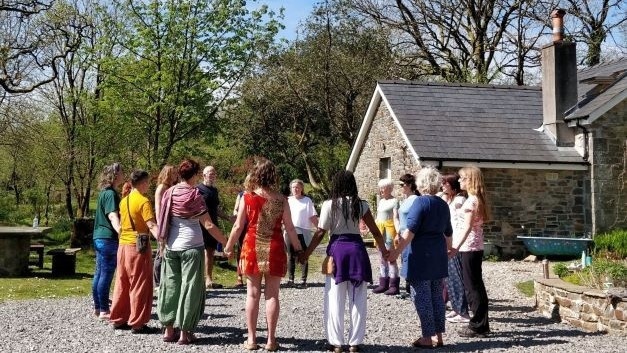Our Background
Mandala Yoga Ashram is proud to belong to an unbroken yoga tradition stretching back thousands of years.
This page provides a brief philosophical and historical overview of the Ashram's place in both the Indian wisdom tradition and the modern Western world.
What is an Ashram?
Ashrams have existed in India for thousands of years, functioning as centres of spiritual inspiration, teachings and dedicated practice. They were often located in remote regions, amidst forests or mountains, but this was not always so. Most villages would have had an ashram of some kind, where the sacred teachings were passed on.
Ashrams still exist high in the Himalayas and in other secluded spots in India, set apart from the noise and busyness of the world to facilitate deep reflection and focus. And they can also still be found nestled within villages, as well as in towns and cities - there are over 300 ashrams in Delhi alone. Further, since the 1960’s a few authentic ashrams have been founded outside India, such as Mandala Yoga Ashram here in Wales.
Ashrams now range from one-person establishments with barely enough room for a handful of visitors to stay, to large institutions with hundreds or even thousands of residents.
Ashrams differ from monasteries in that for most people a visit to an ashram is a temporary retreat rather than a permanent withdrawal from the world. At the same time, a stay in an ashram is also significantly different from attending a workshop or course at a retreat centre.
An authentic ashram is a sacred place where the atmosphere is charged with transformative energy, built up over time through the presence of an enlightened teacher and/or a long period of continuous spiritual practice.
They are usually basic in material terms, providing a simple environment that is light on modern comforts and largely free from the usual distractions of modern life. But on the other hand they are rich in spirit.
People generally go to an ashram to find space to reflect on the deeper meaning or purpose of their life, to study a particular teaching or set of teachings, or for a period of intensive spiritual practice. Moreover, at most ashrams there is a strong spirit of selfless service and an ethos of working towards a goal that is greater than one’s own ego-fulfillment. Different ashrams emphasise different paths and teachings, but all share a broadly similar ethos of focused endeavour aimed at inner growth and transformation.
If we look at the etymology of the word ashram we find the Sanskrit root śram, which means ‘hard work’ or 'toil', with the prefix ā meaning ‘towards’. So, we can see that ashrams are places where we can ‘work towards’ a particular goal. Ashrams are indeed often places of deep inner work, and at times intensive physical endeavour too, with the goal being the realisation and expression of deeper understanding, wisdom and joy.
This generally requires facing and resolving our deep-seated personal problems and negative tendencies so that we can become free from their destructive hold on us - an arduous task which can be very grueling ‘toil’ indeed!
The word ashram also has another Sanskrit root: ashraya – meaning ‘refuge’ or ‘retreat’. This meaning points towards the fact that undertaking inner work within an environment set up for that purpose can be of enormous value. There are two main reasons for this.
Firstly, the material simplicity of ashram life and its freedom from distractions runs us quickly up against aspects of ourselves that we can otherwise easily avoid. This brings clear focus to the task at hand. Secondly, the issues or blocks we are faced with can then be worked on under the guidance of a wise and experienced teacher or teachers, and within a supportive community of others on a similar path. Together, these two aspects of heightened awareness of internal realities and the support of teachings, teacher and community are a powerful combination that can truly help us to catalyse a transformation of our life.
In this way, the ashram tradition is as relevant today as it ever was.
By providing a focused space for us to look inwards to see how we function on a deeper level, and the multifaceted support to help us deal with what we find, ashrams facilitate a process that is valuable both to the individual and to society. For the more deeply we can engage with this process, the more spiritual nourishment and inner strength we uncover in ourselves, which not only brings deeper meaning and joy to our own lives but also gives birth to gifts we can share with the world.
The Yoga Tradition 1000BCE - Today
The history of yoga begins around 3000 years ago in the days of the Vedic culture that flourished in north-western India from 1500 – 500 BCE.
Since that time we can chart the evolution of yoga through a series of developments that have taken it from an ecstatic mystical tradition practiced at the fringes of Vedic society through to a sophisticated system of spiritual philosophy and practice and on to the global wellness phenomenon it is today!
The early teachings from which yoga developed covered a wide field of spiritual enquiry, but at their heart they were concerned with exploring and articulating the essence of mystical experience – the unity of the Self with the Absolute.
The fully developed system of yoga which emerged from the melting-pot of spiritual exploration and development in the centuries between 800BCE and 500CE is generally known as Classical Yoga.
The central feature that distinguishes classical yoga from its pre-classical roots is its highly systematised approach to spiritual practice.
We can say that the essential goal of classical yoga is the progressive interiorisation of the mind: awareness is systematically withdrawn from physical sensations then from feelings and thoughts and inward through increasingly subtle inner states until the innermost self, purusha, is finally realized.
Classical yoga presents a very sophisticated process of facilitating this interiorisation.
The next phase in the historical development of yoga – known as the Post-Classical period – saw the emergence and crystallisation of various forms of yoga which shared the same essential goal and conceptual framework as classical yoga but diverged in method.
Hatha Yoga was one of these forms, emphasising complete mastery and ultimate transcendence of the body through intensive body purification practices and often extreme renunciation, radicalising the already strong ascetic element found in yoga from its earliest origins.
Other forms of yoga that arose around this time included Karma Yoga, Bhakti Yoga, and Gyana Yoga, each appealing to different temperaments in ways that made yoga more accessible to people living normal lives.
Between around 500CE and the late 19th century these paths continued to branch, evolve, and recombine in a myriad of ways, forming innumerable schools and systems of yoga scattered across the Indian spiritual landscape.
The 19th and 20th Centuries saw the arrival of yoga in the West and its subsequent flourishing into a global wellness phenomenon that has moved quite far indeed from both its mystical origins, classical systematisation, and post-classical emphasis on spiritual liberation (moksha).
An estimated 300 million people now practice yoga worldwide, spending around 80 billion dollars per year on classes, certification of teachers, clothing, books, videos, equipment, and holidays.
How extraordinary that what seems to have began 3000 years ago as an ecstatic mystical tradition on the fringes of Vedic society has grown into this global industry.
But of course, much of what goes by the name of yoga today would be virtually unrecognisable to yogis living before the beginning of the 20th century.
The original goal of yoga, expressed as the union of the self and the absolute, has morphed into the goal of fitness and relaxation in the majority of yoga classes.
It’s quite a transformation!
But perhaps this is all well and good. Yoga as exercise is an effective practice offering many benefits, not least among which is a gentle way to reconnect with the body as a source of wellbeing and wisdom. In our world, this is a huge gift.
I’d like to think that the ancient yogis would be happy to know that the tradition they were part of was bringing so much benefit to so many people today.
And, in many cases, practitioners who began their practice as simply a way to unwind and improve their health and wellbeing find themselves at some point becoming more receptive to the deeper gifts that yoga has to offer.
Thankfully, there are places where those deeper gifts are still cherished and nurtured, where the unbroken lineage of spiritual insight and wisdom passed down from ancient times through to the present day is still alive.
Our History
The history of Mandala Yoga Ashram begins in Belfast, Northern Ireland in 1970, when the young man who would later become Swami Nishchalananda first met Swami Satyananda Saraswati.
Already on a yogic path, Swami Nishchalananda attended a series of talks on the different paths of yoga given by Swami Satyananda in the local townhall. The wisdom and practicality of these teachings struck a chord in his heart, and he felt strongly that he had to take time out from his busy life to study yoga on a deeper level. As such, he asked Swami Satyananda if he could go and stay at his ashram in Bihar, India, and was immediately given the okay. In late 1971 he travelled to India and made the ashram – the Bihar School of Yoga – his home.
There he stayed for the next seven years, studying and practising yoga and meditation under Swami Satyananda’s guidance in the high-energy environment of the ashram. Swami Satyananda accepted him as his disciple.
During this time, he wrote a number of books on Yoga under the name of his Guru. These are currently published by the Bihar School of Yoga and include Asana Pranayama Mudra Bandha (1st edition), Meditations from the Tantras, Sannyasa Tantra and A Systematic Course in the Ancient Tantric Techniques of Yoga and Kriya, the latter being an encyclopaedia of yogic science, with special emphasis on Kriya Yoga.
For a further seven years Swami Nishchalananda travelled extensively in India, teaching yoga in large companies, towns and villages. During this time, he also stayed in a number of different ashrams and studied with various spiritual teachers.
During his last two years in India, it was becoming more and more evident to him that he should start an ashram. It was an inner calling. In fact, on a number of occasions, he was even offered land in various parts of India for this purpose. But for one reason or another it never quite happened. Then in June 1985 he returned to the U.K. after fourteen years in India.
This inner prompt to start an ashram continued. There were already a few committed yoga practitioners in the UK who had wanted to start such an ashram to be a centre of yoga practice and tuition. A charity was registered under the name of Satyananda Ashram. But there wasn’t yet a physical location.
Then Swami Nishchalananda remembered a family property in rural Wales that he co-owned with his brother – a tumbledown farm located on 25 acres of land on top of a hill overlooking the Brecon Beacons National Park.
The place was isolated, and the buildings dilapidated. As such, despite its stunning views and the peaceful natural environment, there was initially reluctance to develop the site into an ashram. But somehow the energy was there for it and eventually a group formed. Initially Swami Nishchalananda and Swami Sivadhara, a committed and talented yoga practitioner and teacher, moved in and the project started. That was in July 1986.
For the next ten years the old farm buildings were renovated, and new buildings constructed, mainly with the help of volunteers who came to learn yoga and be part of creating the ashram.
From the very beginning, a range of different yoga courses were organized, including Meditation, Kriya Yoga, Mantra Yoga, Raja Yoga, Bhakti Yoga, Gyana Yoga, Hatha Yoga, Yoga Therapy, Symbols, Pranayama, Chakras, Yoga Nidra and Mudra. In 1990 the first Yoga Teacher Training Course started.
However, conditions were quite tough for residents and visitors alike. Accommodation was extremely basic. Water was collected from a well and had to be boiled before drinking. The long track from the road to the ashram was impassable by anything but a four-wheel drive; vehicles were left at the bottom of the hill and a wheelbarrow was used to carry their belongings up to the ashram and down again!
But eventually the site was worked into shape. A beautiful hall for yoga practice was created, along with comfortable accommodation for thirty people.
During these formative years, the ashram was affiliated with the Bihar School of Yoga, Swami Satyananda’s ashram in India. But in 1996 Swami Nishchalananda chose to make the ashram officially independent from the Bihar School – not due to any conflict with Bihar, but so that the ashram could be free to evolve in its own way and develop its teachings in response to the needs of the western world.
It was at this time that the ashram was renamed Mandala Yoga Ashram.
Since then, the growth and evolution of the ashram has continued – new buildings have been added, the gardens extended, a woodland planted – whilst the ashram’s courses and trainings have continued to share the authentic teachings of yoga, advaita and tantra.
Nowadays, twenty-three years after the ashram’s first website went online in 1999, and in accordance with the needs of the time, the ashram has started offering online courses in addition to its residential retreats.
This has opened its teaching up to a much wider range of people and made them accessible to anyone anywhere in the world via the medium of the internet.
But at the same time the physical location of the ashram, along with the yogic way of life and the spiritual energies nurtured over the past 35 years, remain central to what the ashram is. Its teachings, whilst firmly based on the ancient and authentic culture of yoga, are accessible to those who are living a modern lifestyle yet aspire to go deeper into yoga and live with spiritual awareness day to day, moment to moment.
As the ashram continues to expand online, these strong roots are vital to the integrity of what the ashram teaches and the uniqueness of what it has to offer.
Swami Nishchalananda has always said that it was not him who started the ashram, but rather it was a larger intelligence that worked through him and everyone else who played their part over the years.
And so, in 2021, Swami Nishchalananda handed over the reins of the ashram to Swami SatyaDaya, as Director, and to Swami Krishnapremananda, as Assistant Director.
He is confident that this same underlying intelligence will continue to shape the ashram’s evolution and destiny. He feels that Mandala Yoga Ashram is part of a global paradigm shift from a materialistic perspective to a deeper appreciation of the sacred nature of the earth and all of existence.
The Ashram Today
In line with the ancient tradition of yoga, Mandala Yoga Ashram has since its founding been a place where the process of Awakening is supported and nurtured - a place where that which can barely be imagined can be realised in our own being as the ground of our very existence.
Today we remain as committed to this vision as ever, and to the quality and authenticity of what we teach.
There are many places that people can go for a spa/yoga holiday experience. That is not Mandala Yoga Ashram.
First and foremost, we remain a place for those that are truly seeking deeper understanding about themselves and about the world in which they live.
Yet the ashram can be a valuable respite for all of us living in this fraught and troubled world.
This is an integral part of the ashram’s role – relaxation and letting go are such important aspects of the spiritual path.
However, letting go often involves being confronted with that which needs to be released. From this can come true change and healing - we realise what we are fundamentally and that our current sense of identity is limited at best if not downright illusory.
The times we live in also call for tried and tested tools and techniques which can keep us centered, resilient and vital. Yoga gives us these tools, and the ashram continues to share these simple yet profound techniques that equip us all to be able to meet the challenges of life head on and with an open heart.
Offering the teachings online is going to become an integral part of how Mandala Yoga Ashram reaches seekers and students around the world. We aim to have regular live teachings offered throughout the year and a library of pre-recorded online content that you can practice at home wherever you are. Like us, many of you who have practiced or taught online will have been surprised at the power of connection possible through the practices even at distance.
Residential courses will remain a mainstay of what the ashram offers – ranging from our 2-night Ashram Life Taster to 10-day immersions into subjects such as Facing Death and PranaVidya. As always, we will also offer even longer programs that allow the exploration of subjects such as Kriya Yoga, the Chakras and other profound subjects.
Another form of support that we will begin to offer will be the opportunity for already qualified yoga teachers to further their understanding and experience of the science of Yoga. In this way not only will they come to greater understanding of their own Being, but will also be able to offer a greater depth in their teaching.
Through these different avenues we aim to continue to support seekers, teachers and those looking for meaning in the deepening of their understanding. The ashram will continue to make the timeless essence of the teachings of yoga, meditation, advaita and tantra accessible to a modern Western audience, and foster an environment, both physically and online, that truly encourages genuine spiritual growth.
Residential Retreats & Online Courses

Residential Retreats
Our residential retreats offer high-quality teachings with an emphasis on the cultivation of direct insight, a supportive group field, and opportunity to spend time in the energised sanctuary of the Ashram.

Online Courses
We offer two kinds of online course: live courses broadcast via Zoom, and self-study courses provided through our own online portal. Both are excellent ways to access our teachings from anywhere in the world.
Free Yoga Teachings
In addition to our retreats and courses we offer an extensive free library of high-quality teachings. The library contains a wealth of articles, videos and audios on the philosophy and practice of yoga, advaita and tantra. We believe that genuine spiritual teachings exist for the benefit of everyone, and that money shouldn't be an obstacle to anyone accessing these teachings.
Explore the library
Online Satsang
Join Swami Nishchalananda on Zoom for one-hour satsang sessions. These free sessions usually take place twice per month. Register below to receive invites.

Ashram Sangha
The Ashram Sangha is our new online hub, a space for us to support all those who feel a connection with the Ashram, its teachings, and its vibrant yoga community.

Ashram Shop
In our online shop you can find books and yoga booklets written by Swami Nishchalananda, as well as beautiful malas strung here at the Ashram.


